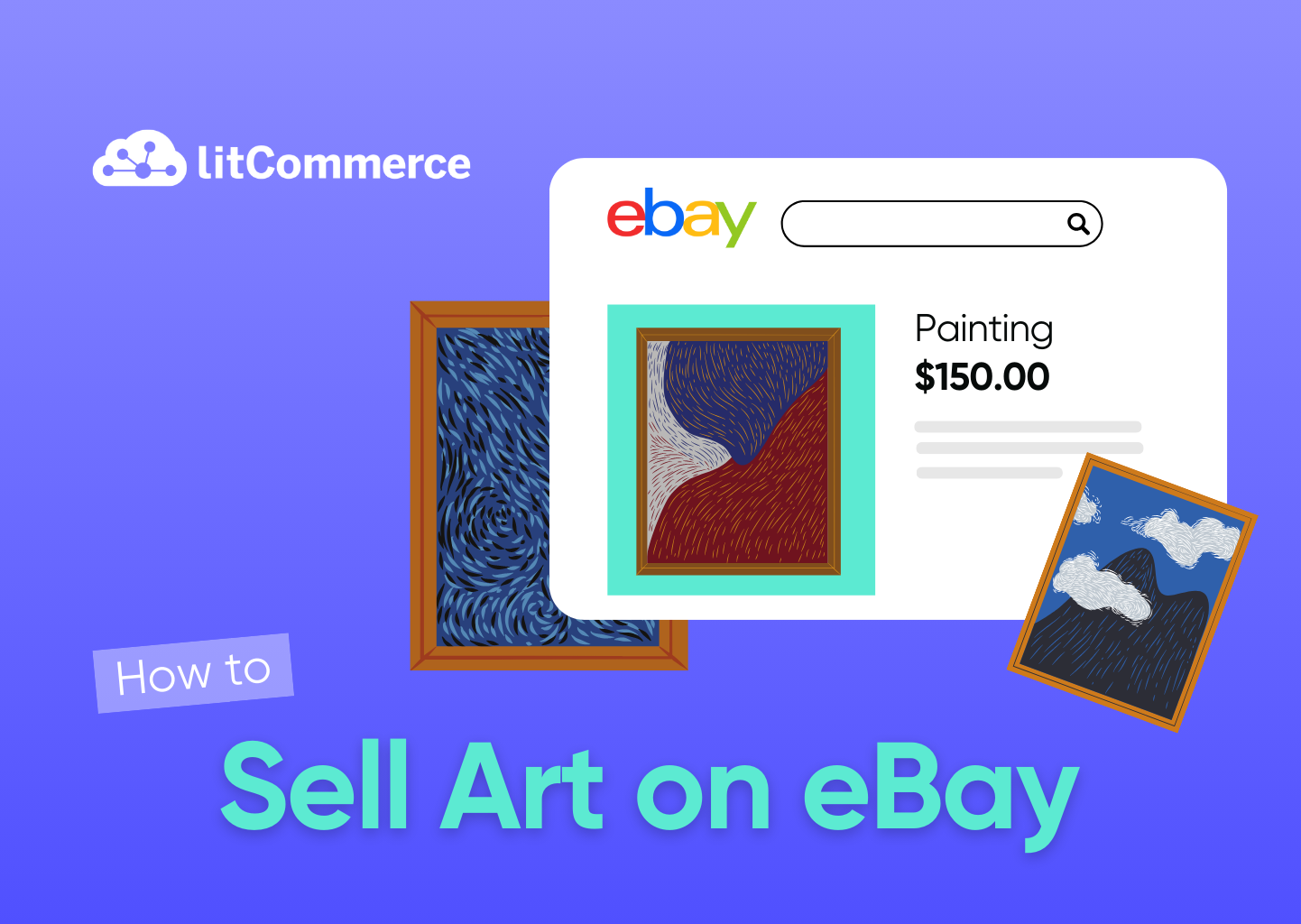If you’re an artist, collector, or reseller looking to turn your creativity or collection into cash, you might be wondering, “Can you sell art on eBay?”. Absolutely. Whether you’re selling original paintings, prints, or digital artwork, eBay can be a powerful platform to reach millions of buyers around the world.
In this guide, we’ll walk you through everything you need to know about how to sell art on eBay, including:
- Is eBay a good place to sell art?
- How to sell art on eBay in 7 steps
- Tips to sell art successfully on eBay
Let’s get started!
Is eBay a Good Place to Sell Art?
First, when searching for how to sell art on eBay, you may wonder: Is eBay a good place to sell art?
Yes, selling artwork on eBay is not only allowed; it’s actively thriving. With a global audience and dedicated Art category, eBay gives you access to both casual buyers and serious collectors. You can list original art and prints, photography, digital illustrations, sculptures, posters, signed pieces, etc.
While platforms like Etsy and Saatchi cater more to handmade and fine art, eBay stands out for its wide buyer base, auction model, and flexible listing options.
How to Sell Art on eBay: Step by Step
Now, it’s time to get your art in front of millions of eBay buyers. Whether you’re a seasoned creator or just starting out, these 7 clear steps will guide you through how to sell art on eBay!
How to sell art on eBay in 7 simple steps:
- Set up an eBay seller account
- Choose the type of art you’ll sell
- Create your artwork
- Create high-converting listings
- Price your art strategically
- Promote your art listings
- Provide excellent post-sale support
1. Create an eBay seller account
Before listing your first masterpiece, you’ll need an eBay seller account. Already have an eBay account for buying? Great, you can use that same login to start selling. If not, here’s how to begin from scratch:
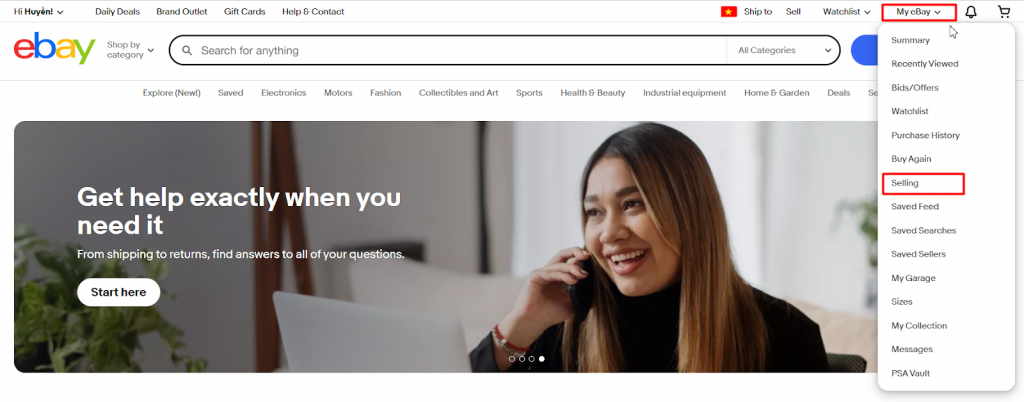
- Go to eBay.com, click on My eBay, and select Selling.
- Choose between a Personal or Business account, then fill out the form to create your account. You can also sign up using Google, Apple, or Facebook for quicker access.
- Once you’re in the Selling Overview, click List an item to access the listing form.
- Complete the required information and hit Submit. This saves your listing as a draft and takes you to your seller dashboard.
- Verify your phone number, set up payment methods, and optionally switch your account type (Individual or Business) based on your needs.
- Review all your details, and submit the form. Once finished, you can start creating a listing and sell art on eBay.
Now that you’ve got your account ready, let’s choose the art you want to sell on eBay.
Step 2: Choose the type of art you’ll sell
Once your eBay account is ready, the next step in selling art on eBay is to choose what kind of art you’ll sell. Picking a niche not only helps define your audience but also sets you apart in a competitive market.
Start by thinking about your artistic strengths or personal interests. Are you drawn to landscapes, portraits, or abstract work? If you’re an experienced artist, lean into your unique style. New to the scene? Look for styles or themes that truly excite you and have room for growth.
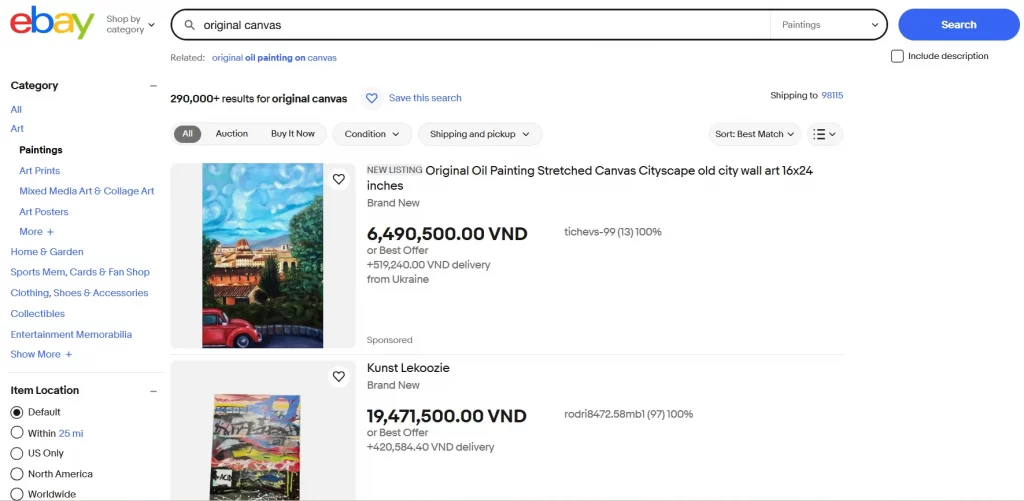
eBay currently supports various art formats. Here are some art formats that can be the product ideas for your art store:
- Original artworks: Sell one-of-a-kind paintings, drawings, or sketches as collectibles.
- Prints & posters: Turn your art into affordable, high-quality prints or posters—perfect for mass appeal and easy shipping.
- Canvas art: Offer giclée or framed canvas prints for buyers looking to elevate their space.
- Home decor: Extend your designs to pillows, blankets, or other decor items for a broader lifestyle audience.
- Stickers: These small, budget-friendly pieces are great for first-time buyers and can act as portable ads for your art.
- Custom clothing: Print your artwork on t-shirts or hoodies to turn your designs into wearable expressions.
Explore your competition on eBay to see what sells well and how you can stand out. Understanding market trends and your unique value will help shape your product line and pricing strategy.
Step 3: Create your art
Now, you’ve decided what to sell on eBay. Before you can actually sell art on eBay, you need to create original pieces that reflect your style and attract potential buyers. If you’re unsure where to start, begin by brainstorming visual ideas and themes that excite you. Sketch rough concepts or build a mood board with images, color swatches, and fonts that match your vision.
Think about the type of product your art will appear on, such as, prints, posters, clothing, or home décor. This will guide your layout, file format, and dimensions.
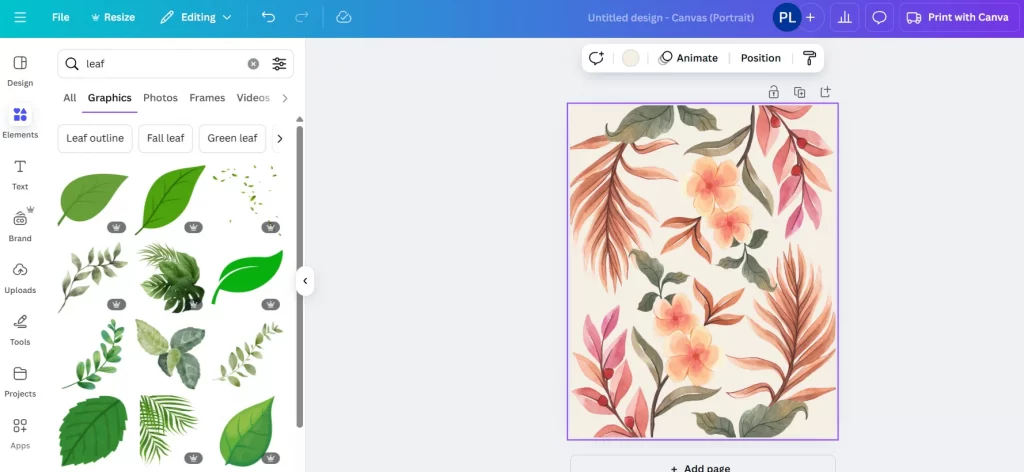
If you have a background in graphic design, take advantage of tools like Adobe Photoshop, Illustrator, or Canva to refine and polish your artwork. Always use the preview feature to see how your design looks on the final product. Once you’re happy with the result, you’re ready to push the product live to your eBay store.
Step 4: Add high-converting art listings
One of the most important parts of learning how to sell paintings on eBay or sell art is creating listings that don’t just attract traffic, but convert it into actual sales. A well-optimized listing helps boost visibility in search results and builds buyer confidence. Here’s how to do it right:
Start by usingg eBay’s search bar to explore related terms when typing in your artwork’s title. Look at auto-suggestions and analyze top-performing listings for keyword ideas. Tools like Keywords Everywhere and KeywordTool.io can give you deeper insights into search volume and competition. You can also visit eBay Seller Hub and WatchCount.com to find trending products and keyword opportunities.
Then, optimize every listing element for your art to ensure it meets the eBay SEO requirements:
- Title: Use one strong focus keyword (e.g., “abstract watercolor print”) and keep it readable. Avoid keyword stuffing.
- Description: Include your main keywords naturally, aiming for a 5–7% keyword density. Write clear, honest descriptions that highlight the medium, dimensions, style, and story behind the art.
- Images: Upload high-quality photos from multiple angles. Show details, textures, and how the piece looks framed or in a real space. If you use print-on-demand, include mockups for different formats (e.g., canvas, poster, apparel).
- Seller Profile: Align your eBay store name with your niche, write a brief but keyword-rich profile description (within the 250-character limit), and use a clean, professional profile photo (300x300px, 72 DPI).
By thoughtfully optimizing this information, you’ll not only increase your visibility but also improve your chances of turning views into sales.
Step 5: Price your art strategically
A smart pricing strategy is also the key to selling art on eBay successfully. eBay offers two main pricing formats: Buy It Now and Auction, each suited to different types of artwork and selling goals.
- Buy It Now: This option lets you set a fixed price. Buyers can purchase instantly without bidding. It’s perfect for art prints, digital downloads, or pieces you’ve sold before. Use Buy It Now when you want consistent pricing and quicker sales.
- Auction: With auctions, you set a starting price and let buyers bid over a set time (usually 7–10 days). The highest bidder wins. Auctions work best for original or rare pieces where you want the market to determine value. They also create urgency and excitement.
When pricing your art, don’t forget the eBay selling fees. To stay profitable, make sure to factor in eBay’s listing and final value fees. Sellers get up to 250 free listings per month; after that, it’s $0.35 per listing. For most art, eBay charges 12.7% of the total sale amount (up to $2,500) and 2.35% on anything above that. Art NFTs have a 5% fee. Thus, always calculate your costs, including shipping, materials, and fees, before setting a price.
Moreover, you should research similar listings on eBay to compare prices. Try both formats to see which performs better with your audience. A flexible pricing approach helps you sell more effectively and grow your art business on eBay.
Step 6: Promote your art listings
Once you’ve launched your brand, it’s time to promote your art listings to attract more buyers and grow your eBay store.
Start by building a strong and recognizable brand for your eBay store. Create a memorable logo, stick to consistent colors, and craft a message that reflects your artistic style.
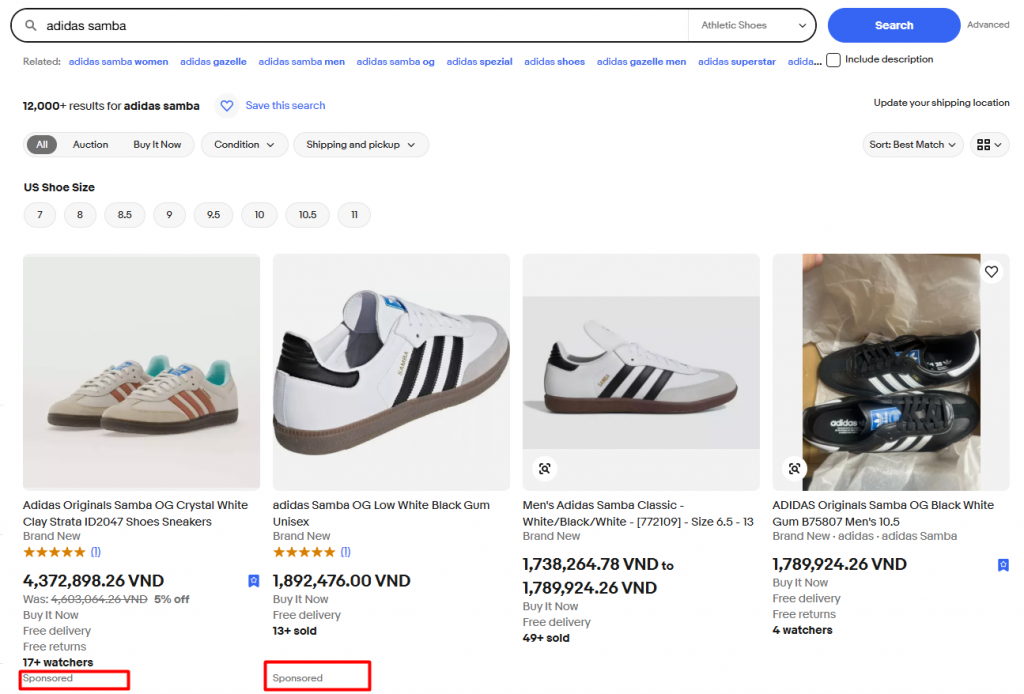
Next, attract buyers by offering limited-time deals like seasonal sales, discount codes, or product bundles. Promotions such as percentage discounts or “buy one, get one free” can make your listings stand out in search results and encourage more clicks. Use eBay’s built-in marketing tools to manage special offers, bulk pricing, and instant coupons. These features simplify your promotional efforts and help maximize your results.
To reach even more potential buyers, promote your artwork across social platforms like Instagram, Facebook, TikTok, and Pinterest. Share updates, behind-the-scenes content, and offers, and always include relevant hashtags to boost visibility.
Step 7: Provide excellent post-sale support
If you want to master how to sell art on eBay long-term, your job doesn’t end once a piece is sold. Providing excellent post-sale support is key to earning positive feedback, encouraging repeat purchases, and building a trustworthy reputation as a seller.
Start by packaging your artwork with care. Always ship quickly because buyers appreciate fast handling times. Use protective materials like bubble wrap, corner guards, and sturdy boxes to prevent damage during shipping. Include a personal thank-you note or branded insert to add a thoughtful, professional touch.
Once the item ships, send a quick message to the buyer with tracking information and estimated delivery time. This builds trust and reduces unnecessary concerns.
If a buyer reaches out with questions or issues, respond quickly and politely. Resolving concerns promptly shows reliability and increases the likelihood of a 5-star review.
Tips to Sell Art Successfully on eBay
Once you’ve learned the basics of how to sell art on eBay, the next step is fine-tuning your strategy to stand out and boost sales. Here are 5 essential tips to help you succeed as an art seller on eBay:
1. Use high-quality photographs
In the art world, visuals are everything, so use the best art photos as possible.
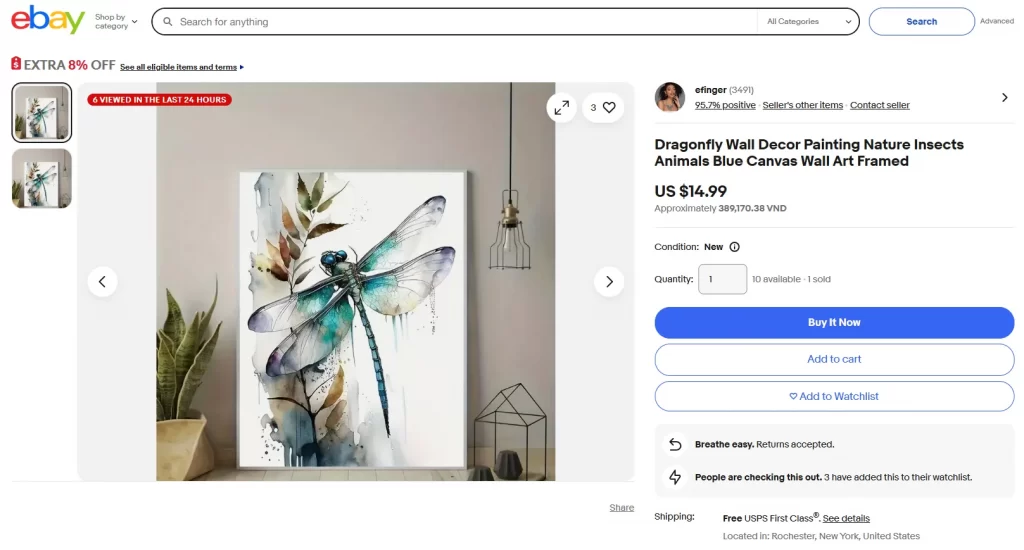
Use a DSLR camera or a good smartphone in a well-lit area with natural light. Avoid harsh shadows and cluttered backgrounds. Photograph your art from multiple angles, and include close-ups to show textures, brush strokes, or signature details. If possible, stage your artwork in real-life settings, like hanging on a wall or in a frame, to help buyers picture it in their space. Always crop and resize your photos to focus on the art, not the background.
eBay allows up to 12 images per listing, so use them! Clear, professional-looking photos not only draw more views but also reduce returns by setting the right expectations.
2. Optimize for eBay search (eBay SEO basics)
To increase your chances of getting discovered, you need to understand eBay’s search engine, Cassini. Start by including keywords naturally in your title, think medium, size, style, subject, and any unique traits (e.g., “Framed Watercolor Landscape Painting 11×14 – Original Wall Art”).
Keep titles readable, avoid keyword stuffing. Use all available item specifics and categorize your listing correctly to improve visibility. In the description, add storytelling elements: talk about your inspiration, techniques, or the story behind the piece. This creates a richer experience for buyers and reinforces your credibility.
Best practice: Before listing, search for similar artworks on eBay. Note which keywords and formats appear in top-ranking listings, and use those insights to guide your own.
3. Balance Auctions and “Buy It Now” listings
When learning how to sell art on eBay, knowing when to use auction vs “Buy It Now” can make a big difference.
Auctions are ideal for rare, high-demand originals, or if you want to test market value. Set a reasonable starting price and run the auction for 7 to 10 days, ending on a Sunday evening when buyer activity peaks. On the other hand, “Buy It Now” is better for prints, reproductions, or artworks you can restock. It appeals to buyers who prefer immediate purchases without bidding.
Best Practice: Start with both formats. Use auctions to generate attention and test pricing, then switch to “Buy It Now” for consistent sales. For your best-sellers, consider creating variations (e.g., different sizes or framing options) to give buyers more choices.
4. Encourage and learn from feedback
Feedback plays a huge role in building your reputation as a trustworthy artist. The more positive reviews you collect, the more confident new buyers will feel about purchasing from you, which is an important part of growing a sustainable art business on eBay.
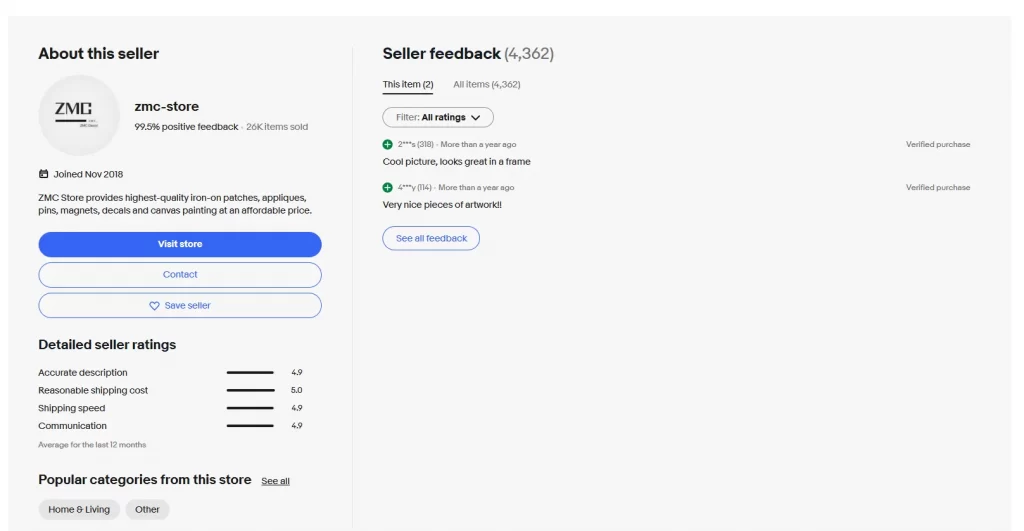
After every sale, politely ask buyers to leave a review, especially if they express satisfaction. You can do this via eBay’s messaging system or automated email follow-ups. Always respond promptly and professionally to any concerns. If a buyer has an issue, resolve it quickly and use it as a learning opportunity.
Best practice: Analyze your reviews regularly. Are buyers consistently praising your packaging, speed, or product quality? Highlight those strengths in your listings. Negative or neutral feedback? Use it to improve processes, like adjusting shipping times or adding clearer product details.
5. Brand your art business
Even if you’re just starting to sell art on eBay, treat your eBay store like a real business. Branding creates a memorable experience that helps buyers recognize and return to your shop. By building a brand, you’re not just selling one piece of art; you’re creating a loyal audience that believes in your story and will keep coming back for more.
Best practice:
- Use a consistent visual style across your product photos, logo, and store banner.
- Write a compelling artist bio that shares your background, inspiration, and creative process.
- Create a custom store name that reflects your artistic identity and makes your shop easy to remember.
- Use that branding across your packaging, thank-you notes, and even social media profiles if you have them.
How to Sell Art on eBay – FAQs
Is it worth selling art on eBay?
Yes! eBay has a large, active buyer base and low upfront costs, which is great for artists and collectors alike.
How much does it cost to sell art on eBay?
The cost of selling art on eBay includes listing and final value fees. You get up to 250 free listings per month; after that, it costs $0.35 per listing. The final value fee for most art categories is 12.7% on the total sale amount up to $2,500 and 2.35% on any amount over $2,500. If you’re selling Art NFTs, the cost is 5% of the total sale.
Is it better to sell art on Etsy or eBay?
Both platforms have unique strengths. Etsy attracts buyers looking for handmade and vintage art, often allowing for higher pricing in a niche market. Meanwhile, eBay offers access to a larger, more diverse audience, which can lead to faster sales but often involves more competition and lower prices.
What is the best platform to sell art on?
There isn’t a single “best” platform for selling artwork, as it depends on your needs. Etsy is great for handmade art, Saatchi Art works well for gallery exposure, and Fine Art America or Society6 are solid for print-on-demand. Additionally, eBay is ideal for reaching a wide audience, testing different formats, and selling both originals and prints. For full branding control, Shopify lets you build your artwork online store.
Final Thoughts: Is Selling Art on eBay Worth It?
Mastering how to sell art on eBay goes beyond just listing your work. It’s about choosing the right type of art, connecting with your ideal buyers, creating standout listings, and offering an experience that keeps collectors and casual shoppers coming back. With the right approach, your creative passion can evolve into a steady source of income, whether it’s a side hustle or a full-fledged business.
Ready to grow even more? If you’re thinking about selling your art beyond eBay, LitCommerce has you covered. Our powerful multichannel selling tool helps you list, sync, and manage your products across platforms like Amazon, TikTok Shop, Shopify, WooCommerce, Wix, and more, all in one place.
Give our eBay integration a try today, or reach out to our team if you have questions. We’re here to help you turn your art into a thriving online business.

